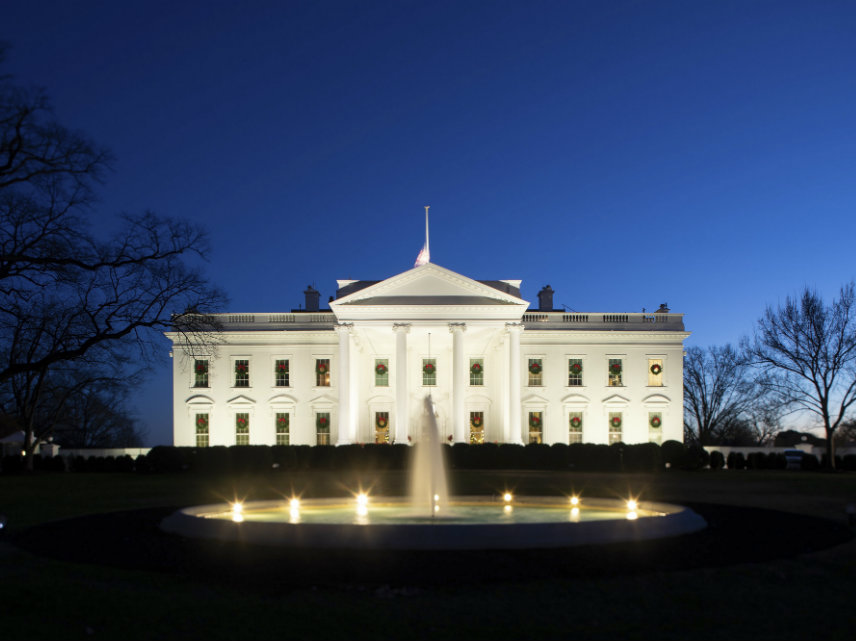Trump's Budget Would Add $7.9 Trillion to the National Debt Over the Next Decade
And the real outcome is likely to be worse, since the budget relies on overly rosy assumptions about future economic growth.

Page 1 of President Donald Trump's proposed budget boldly promises to tame America's runaway national debt, which recently surpassed $22 trillion and continues to grow.
"My 2020 Budget builds on the tremendous progress we have made and provides a clear roadmap for the Congress to bring federal spending and debt under control," Trump writes in a message to Congress that serves as the introduction to the budget plan. "We must protect future generations from Washington's habitual deficit spending."
Unfortunately, most of the rest of the 150-page budget undermines the opening salvo. Trump's budget relies on "accounting gimmicks" long popular with both parties, such as using overly rosy economic projections to make an end-run around budget caps that his fellow Republicans once championed. The proposed budget would run trillion-dollar deficits in each of the next four years, and would take 15 years to balance—even with the optimistic assumptions about future economic growth—five years longer than the Trump administration's first budget promised.
The budget proposal released Monday also puts to bed the question of whether Trump can keep his campaign promise to eliminate the national debt in eight years.
Indeed, under the projections included in the budget plan, the country would run a deficit of $631 billion in 2025 (which would be Trump's eighth budget, if he remains in office that long)—hardly smaller than the $666 billion deficit in the final fiscal year of Preisdent Barack Obama's time in office.

Over 10 years, Trump's budget would add more than $7.9 trillion to the national debt.
The real outcome is likely to be much worse than the estimates provided Monday by the White House. That's because Trump's budget assumes 3 percent annual economic growth for the next decade, a figure that's well in excess of what most economists expect. The Federal Reserve, for example, projects 2.3 percent growth over the next year.
Without those overly rosy assumptions, the national debt would likely be $2 trillion higher by 2029, according to an analysis by the Committee for a Responsible Federal Budget (CRFB), a nonpartisan group that advocates for balanced budgets. The group says the budget is likely to add about $10 trillion to the national debt by 2029.
"President Trump's budget aims to reverse an unsustainable fiscal situation and put debt on a downward path relative to the economy," says Maya MacGuineas, president of the CRFB. "Unfortunately, as in previous years, he relies on far too many accounting gimmicks and fantasy assumptions and puts forward far too few actual solutions."
The latest projections from the Congressional Budget Office assume lower levels of future revenue than the Trump budget does. As a result, the CBO does not expect the deficit to decline during the next decade, and expects that it will reach $1.3 trillion annually by 2029.
While likely exaggerating future economic growth, Trump's budget also overstates the likelihood of achieving reductions in domestic spending.
Perhaps the best example of unrealistic spending cuts are the $660 billion in savings that the budget assumes would come from repealing and replacing Obamacare—a policy that couldn't get through Congress when Republicans controlled both chambers and seems virtually impossible now that Democrats hold the House. Already, Democrats are slamming Trump's budget for the non-defense discretionary cuts the administration has proposed.
Worse, Trump's budget attempts to hide spending increases for the Pentagon by moving those new funds into off-the-books accounts originally meant to pay for America's foreign wars. The administration says it wants to tackle wasteful spending in welfare and other domestic programs, but there's plenty of wasteful spending at the Pentagon, too. It's hard to take the president's calls for belt-tightening seriously when the cuts only apply to some parts of the federal budget.
Balancing a budget that's $22 trillion in the red is not easy, of course, but the first requirement should be to stop making matters worse.
"The nation has never been in such a troubling fiscal situation," writes Chris Edwards, director of tax policy studies at the Cato Institute, a libertarian think tank. "Federal debt is soaring even after a decade of economic growth. Debt is imposing a rising cost that burdens all of us. Politicians have always had incentives to spend, but never before has Washington been so irresponsible."
Trump's budget also calls for the extension of the 2017 tax cuts, which are currently expected to expire in 2025. As Edwards points out, the budget could balance within 10 years—even with lower expected revenues by keeping the tax cuts in place—if annual spending growth was restrained to 1.8 percent.
That's a reasonable figure. Too bad this budget ignores it.

Show Comments (51)